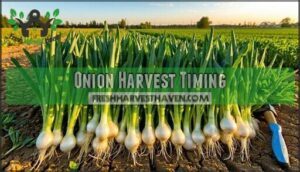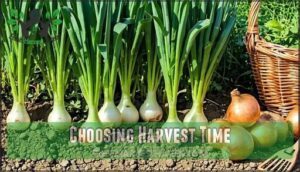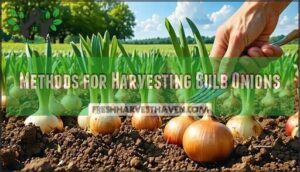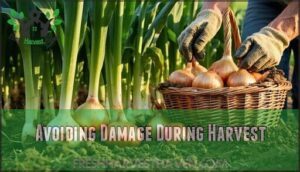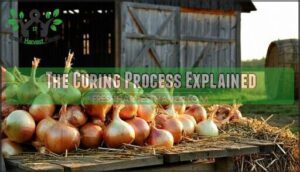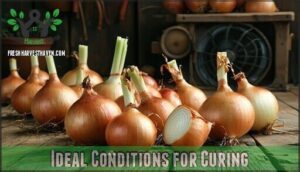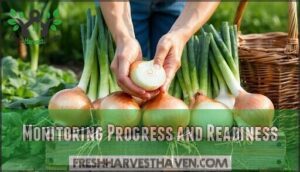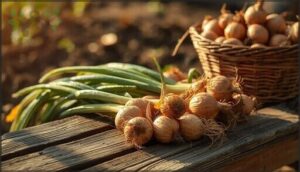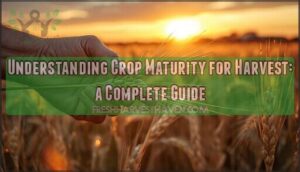This site is supported by our readers. We may earn a commission, at no cost to you, if you purchase through links.
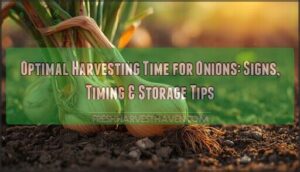
The ideal harvesting time for onions typically falls between 90-120 days after planting, when bulbs reach full size and necks soften.
Check for loose, papery outer skins and firm bulbs beneath.
Don’t wait too long though – overripe onions won’t store well and might split.
Weather matters too; harvest during dry conditions to prevent rot.
Pull a test onion if you’re unsure – it should feel solid and heavy.
The timing dance between too early and too late makes all the difference for storage success.
Table Of Contents
- Key Takeaways
- Onion Harvest Timing
- Choosing Harvest Time
- Harvesting Onion Basics
- Curing Onions Process
- Storing Onions Long Term
- Onion Varieties Harvest
- Post Harvest Care
- Frequently Asked Questions (FAQs)
- How do you know when onions are ready to dig up?
- Can you leave onions in the ground too long?
- Can you wait too long to harvest onions?
- How long do you leave onions to dry?
- What is the best month to harvest onions?
- How long do onions take to be harvested?
- How do you know when onions are ready to be picked?
- When should you stop watering onions?
- How does weather impact onion harvest timing?
- Can onions be harvested prematurely and used?
- Conclusion
Key Takeaways
- Watch for natural signals – You’ll know it’s time when 50-90% of the green tops fall over and turn brown at the neck, typically 90-100 days after planting.
- Stop watering early – Cut off irrigation 2-3 weeks before harvest to prevent bulb rot and encourage proper skin formation for better storage.
- Harvest in dry conditions – Choose dry weather to pull your onions, as wet soil increases disease risk and makes bulbs harder to cure properly.
- Cure for 2-4 weeks – After harvesting, dry your onions in warm, well-ventilated areas until outer skins become papery before storing long-term.
Onion Harvest Timing
You’ll know your onions are ready to harvest when their green tops naturally fall over and turn brown at the neck, typically occurring 90-100 days after planting from seed.
Timing this harvest correctly guarantees maximum bulb size and ideal storage life, as pulling too early results in smaller onions while waiting too long can lead to splitting or rot, affecting the overall storage life.
Signs of Onion Readiness
Five key onion maturity signs tell you when to harvest onion bulbs.
Watch for leaf senescence – when 50-90% of green tops flop over at the neck, signaling completed bulb formation.
The neck softens and turns papery while outer skin becomes dry.
These harvest signals indicate crop readiness and ideal onion harvest time for storage.
Proper onion storage tips are essential for maintaining the quality of the harvested onions, which is crucial for long-term preservation.
Factors Affecting Harvest Time
Several factors influence your onion harvest time beyond visual maturity signs.
Soil moisture levels play a critical role – wet conditions can delay harvest and increase disease risk, while dry soil makes bulbs easier to lift.
Weather patterns affect crop maturity timing, as cool springs extend growth periods while hot summers accelerate bulb development.
Your harvest scheduling should consider these variables for yield optimization, ensuring onions reach peak size before weather turns unfavorable, which is crucial for a successful onion harvest and requires careful planning to avoid disease risk.
Importance of Timing for Onion Quality
Timing dictates everything in onion cultivation.
Harvest too early, and you’ll sacrifice bulb size and storage potential—your onions won’t reach maximum onion yield.
Wait too long past when to harvest onions, and bulbs may split or sprout, ruining months of careful soil preparation.
Proper harvest scheduling during onion harvest season maximizes crop yield and ensures your timing strategies pay off beautifully.
Understanding the onion harvest signs is vital for determining the best time to collect your onions, considering the importance of onion harvest season and harvest signs.
Choosing Harvest Time
You’ll know it’s time to harvest your onions when the soil conditions are just right and you’ve given them proper pre-harvest care.
The key is watching for dry soil that won’t damage the bulbs during extraction, while ensuring you haven’t waited so long that the onions start deteriorating in overly wet conditions, which requires proper care.
Soil Conditions and Moisture Levels
You’ll want to check soil moisture levels before onion harvesting begins.
When soil’s too wet, your drainage methods need improvement to prevent bulb rot.
Dry conditions work best – aim for soil moisture around 50-60% field capacity.
Irrigation systems should stop watering two weeks before harvest.
Test your soil pH (6.0-7.0 ideal) since it affects nutrient uptake during final onion growth stages, directly impacting perfect onion yield through proper onion crop management.
Avoiding Damage During Growth
Protecting your onions during growth prevents setbacks that could ruin your harvest.
Apply mulch around plants to regulate soil temperature and maintain consistent Water Management – extreme swings stress bulbs and trigger premature bolting.
Use Pest Control barriers like mesh screens during peak insect seasons, and choose resistant varieties to minimize thrips and aphid damage.
Practice Crop Rotation every three years to break disease cycles.
Shallow cultivation protects roots from mechanical injury while proper Fertilizer Use strengthens plants against bacterial diseases.
Effective onion care involves understanding onion growing challenges to guarantee a healthy crop.
Pre-Harvest Care for Optimal Results
Water management becomes your secret weapon during pre-harvest. Stop irrigation 7-10 days before harvest to prevent bulb rot and encourage proper skin formation.
Apply balanced fertilizer early in the season, then cease feeding 4-6 weeks before harvest. Monitor for thrips and onion maggots using integrated pest control methods.
Proper soil preparation and crop rotation support healthy onion bulb formation, maximizing your ideal onion yield through strategic onion care tips. Understanding harvest timing factors is vital for a successful onion harvest with the right harvest timing.
Harvesting Onion Basics
Once you’ve determined your onions are ready for harvest, proper technique makes all the difference between quality bulbs and damaged crops.
You’ll want to handle both green onions and mature bulbs differently to maximize your yield and storage potential, ensuring that you can enjoy your harvest for a longer period by applying the right technique.
Techniques for Harvesting Green Onions
Green onions harvest differently than bulb varieties since you’re after tender shoots, not mature bulbs.
Cut scallions at soil level using sharp scissors or a knife when they reach 6-8 inches tall.
For continuous harvests, use proper onion thinning techniques – harvest every other plant first, this approach lets remaining plants develop while you enjoy fresh harvests throughout the growing season, using a Green Onion Care method.
This method allows for the enjoyment of fresh harvests, and by following these steps, one can have a successful continuous harvest.
Methods for Harvesting Bulb Onions
After loosening bulbs from beneath the soil, you’ll need proper onion tools and timing for successful bulb formation.
Manual harvesting remains the gold standard for onion harvesting, especially when soil preparation and crop rotation create ideal conditions.
Effective use of an onion harvest tool is essential for maximizing yields.
- Fork method: Gently loosen soil around bulbs before pulling to prevent skin damage
- Timing matters: Harvest when necks shrivel and tops fall naturally for best onion yield optimization
- Handle with care: Pull by tops, not bulbs, to maintain integrity for curing onions
Avoiding Damage During Harvest
Handle each bulb like you’re holding an egg – one wrong move and you’ve got a bruised mess.
Use proper harvest tools and gentle harvesting techniques to avoid nicks that invite rot. Loosen soil around bulbs before pulling, never yank from the tops.
Clean farm equipment prevents disease transfer between plants.
Perfect harvest timing means firm, intact onions ready for curing.
Curing Onions Process
After you’ve harvested your onions, proper curing transforms them from fresh bulbs into storage-ready produce that can last for months.
You’ll need to dry those outer layers until they form a protective papery skin that seals in freshness and prevents rot.
The Curing Process Explained
Curing transforms your freshly harvested onions into long-lasting storage champions.
This onion drying process removes excess moisture from outer layers, creating a papery protective shell around the bulb.
You’ll need to cure onions for two to four weeks after harvesting onions, allowing proper airflow around each bulb.
The curing process is essential crop management that prevents rot and extends storage life substantially.
Understanding the onion curing process is vital for achieving the best results, and is a key part of proper airflow and storage life management.
Ideal Conditions for Curing
Between 75-85°F with humidity below 75%, your onions need proper air circulation during the curing process.
Set up fans providing 2 cubic feet per minute airflow around loosely arranged bulbs.
Avoid direct sunlight—it’ll scorch those papery skins you’re working to develop.
Think of it as creating a gentle breeze in your grandmother’s attic: warm, dry, and moving air transforms fresh bulbs into storage-ready onions, much like a gentle breeze.
Monitoring Progress and Readiness
Check your onions every few days during the curing process.
Look for papery, dry outer skins and firm necks – these maturity indicators signal proper curing.
The bulbs should feel solid when gently squeezed.
Crop monitoring during this stage prevents spoilage and guarantees successful onion storage.
Well-cured onions develop protective layers that extend shelf life substantially, and this is a result of proper curing process.
Storing Onions Long Term
Once you’ve properly cured your onions, you’ll want to store them in conditions that prevent sprouting, rot, and moisture buildup.
The key is maintaining cool, dry, well-ventilated storage areas with temperatures between 32-40°F and humidity levels around 65-70%, which helps in preventing moisture buildup and maintaining the quality of the onions.
Preventing Common Storage Problems
After proper curing, you’ll face storage challenges that can ruin your harvest if ignored.
Smart moisture control and humidity management prevent most problems before they start.
- Keep storage temperature between 32-40°F – Higher temps accelerate sprouting and decay
- Maintain 65-70% humidity levels – Too dry causes shriveling, too wet promotes rot
- Inspect weekly for spoilage detection – Remove soft, sprouting, or moldy bulbs immediately
- Use breathable containers – Mesh bags allow airflow while blocking light exposure
To help maintain ideal conditions, consider using perforated bags usage to guarantee adequate airflow.
Maintaining Optimal Storage Conditions
Why worry about perfect storage when your onions can spoil from simple mistakes?
Maintain temperature management between 32-40°F with humidity control at 65-70%.
Use storage containers with proper air circulation to prevent moisture levels from causing rot.
Well-ventilated mesh bags work better than plastic for longterm storage, extending onion storage life substantially when combined with proper curing methods.
Onion Varieties Harvest
Different onion varieties reach harvest readiness at slightly different times, but they all share the same key indicators.
You’ll notice red, white, and yellow onions are ready when their tops fall over naturally and turn brown at the neck – this universal signal works regardless of the variety you’re growing, indicating harvest readiness.
Red Onions Harvesting
Red onions demand precise timing for maximum onion yield. These ruby gems signal readiness when necks soften and tops collapse—nature’s own harvesting alarm clock.
- Monitor bulb emergence – Red onions push 2-3 inches above soil when mature, showcasing their vibrant color
- Check leaf status – Harvest when one-third to half the leaves yellow and fall over naturally
- Test neck flexibility – Soft, bendable necks indicate finished growth; firm necks need more time
Red Onion Care throughout the season directly impacts your onion harvesting success. Proper Onion Soil Prep and attention to Red Onion Diseases guarantees healthy bulb development.
These Red Harvest Tips maximize your Onion Crop Yield when onion maturity peaks. Master these onion harvest techniques for consistently excellent results. Understanding the onion harvest signs is vital for a successful harvest.
White Onions Harvesting
White onions’ tender skin requires gentle handling during onion harvesting to maximize ideal onion yield.
These delicate bulbs reach onion maturity when necks soften and tops fall naturally.
Use proper harvest tools like garden forks to avoid bruising during white cultivation.
Best time to harvest arrives when foliage browns completely.
Good soil preparation and crop rotation enhance storage quality substantially, and proper handling from harvest to storage is crucial for maintaining the ideal onion yield and ensuring the onions have a tender skin.
Yellow Onions Harvesting
Since yellow onions are the most common storage variety, you’ll want to time their harvest perfectly for maximum onion yield.
Watch for tops to naturally fall over and turn brown—that’s your green light for onion harvesting.
Use proper harvest tools to gently lift bulbs, ensuring soil prep and crop rotation support next season’s farm management goals.
Post Harvest Care
Once you’ve harvested your onions, proper post-harvest care determines whether they’ll last weeks or months in storage.
You’ll need to handle them gently, create the right storage conditions, and check regularly for signs of spoilage to maximize your harvest’s shelf life.
Handling and Packaging Onions
Handle freshly harvested onion bulbs gently to prevent bruising and damage during postharvest handling. Use breathable packaging materials like mesh bags or wooden crates that allow airflow while protecting bulbs.
Proper onion handling requires clean farm equipment and sanitized storage solutions. Avoid plastic containers that trap moisture and promote rot.
Sort bulbs by size and quality before packaging to guarantee uniform crop protection and achieve the best curing results.
For long-term preservation, consider using onion storage methods to maintain freshness and ensure the onions remain in good condition, which is crucial for proper onion handling.
Controlling Storage Environment
After curing, you’ll need precise environmental controls to maintain onion quality.
Set storage temperatures between 32-40°F with 65-70% humidity levels for ideal preservation.
Install fans for consistent air circulation, preventing moisture buildup that causes rot.
Clean storage areas thoroughly before placement, ensuring dry conditions throughout the storage period, with consistent air circulation and precise environmental controls.
Checking for Spoilage and Rot
Regular onion inspection prevents costly storage losses and helps your harvest stay fresh.
Check stored onion bulbs weekly during the first month, then monthly afterward for maximum decay prevention.
Key spoilage signs to monitor:
- Soft spots – Press gently; healthy bulbs feel firm throughout
- Dark discoloration – Brown or black patches indicate onion rot
- Sprouting – Green shoots signal declining storage quality
- Musty odors – Fresh onions smell clean and sharp
- Moisture buildup – Dampness accelerates spoilage in storage containers
Remove affected bulbs immediately to protect remaining stock.
Frequently Asked Questions (FAQs)
How do you know when onions are ready to dig up?
Like a green flag surrendering to autumn’s call, your onions signal harvest readiness when their tops naturally topple over and turn brown at the neck, indicating bulb maturation is complete.
Can you leave onions in the ground too long?
Yes, you can leave onions in the ground too long.
Overripe onions develop thick necks, making them prone to rot during storage.
They’ll also start sprouting again, wasting energy and reducing bulb quality.
Can you wait too long to harvest onions?
After 100 days of growth, you’ll definitely regret waiting too long – overripe onions split, rot, and lose their storage potential once tops completely die back.
How long do you leave onions to dry?
After harvesting, you’ll cure onions for 2-4 weeks in a warm, dry, well-ventilated area. Proper curing creates that papery outer skin that protects your onions during storage.
What is the best month to harvest onions?
You’ll want to harvest onions in July through August when their tops naturally fall over and turn brown.
This signals they’ve reached maturity and stopped growing, making it the perfect window for pulling them up.
How long do onions take to be harvested?
Like clockwork from your grandfather’s pocket watch, you’ll need patience – onions require 90-100 days from seed or 80 days from transplants to reach maturity for harvest.
How do you know when onions are ready to be picked?
You’ll know your onions are ready when their tops naturally fall over and turn brown at the neck.
The leaves should feel dry and papery, not green and sturdy like during growth.
When should you stop watering onions?
Stop watering your onions about two to three weeks before harvest, when their tops start yellowing and falling over naturally.
This drying period helps concentrate flavors and prepares bulbs for proper curing and storage.
How does weather impact onion harvest timing?
Weather acts like nature’s stopwatch for your onion harvest.
Hot, dry conditions signal bulbs to mature faster, while cool, wet weather delays readiness.
You’ll need to adjust timing based on rainfall and temperature patterns affecting bulb development.
Can onions be harvested prematurely and used?
Yes, you can harvest onions early, but they won’t store well and will have milder flavor.
Young onions work great for immediate cooking – think green onions or scallions.
They’re perfectly edible, just different from fully mature bulbs.
Conclusion
Like the proverbial early bird catching the worm, mastering the ideal harvesting time for onions determines your storage success.
You’ve learned to read nature’s signals – yellowing tops, softening necks, and papery skins.
Remember, timing beats perfection every time.
Harvest during dry weather, cure properly, and store in cool, ventilated spaces.
Whether you’re growing red, white, or yellow varieties, these fundamentals remain constant.
Your patience and observation skills will reward you with onions that last months, transforming your harvest from seasonal abundance into year-round kitchen staples, and ensuring year-round availability with proper storage.

